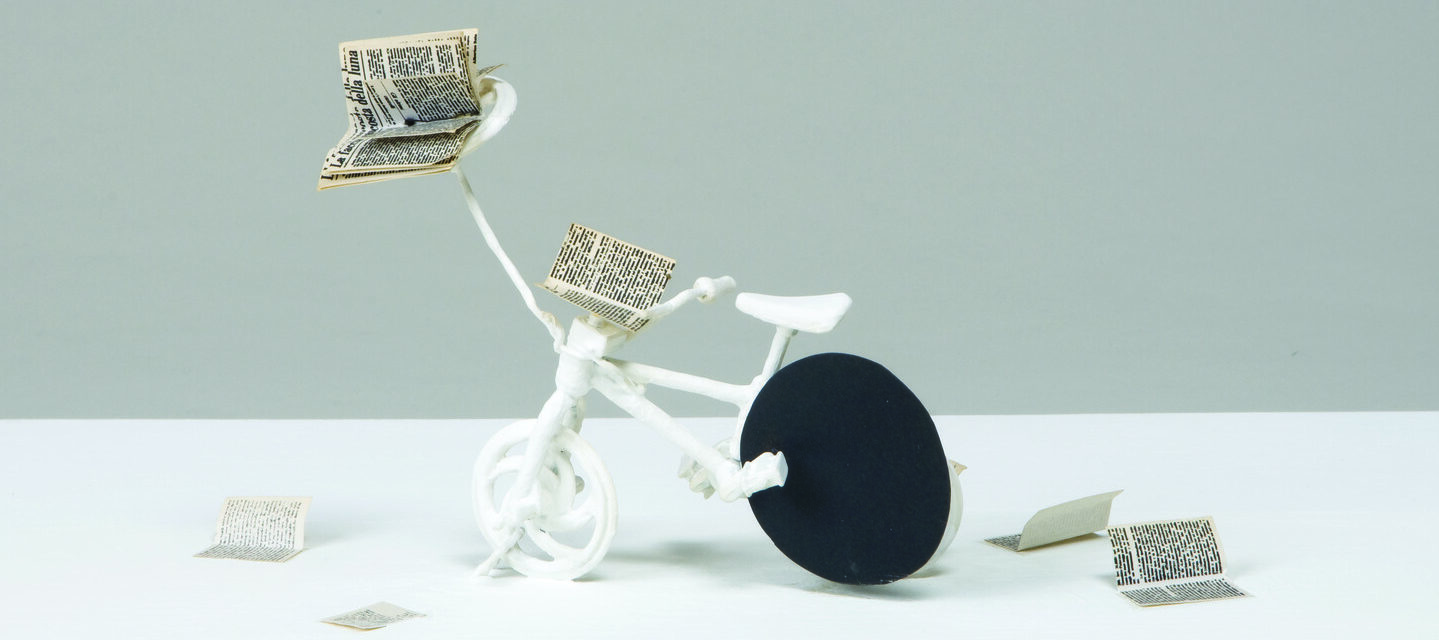WASHINGTON—The National Museum of Women in the Arts (NMWA) presents Books Without Words: The Visual Poetry of Elisabetta Gut, the Italian artist’s first American solo exhibition. Featuring more than 20 of her artists’ books, collage-poems, book-objects and object-poems, the exhibition will be on view at NMWA from September 10, 2010, to January 16, 2011.
Elisabetta Gut carefully crafts her work from her dreams, memories, and love for music and poetry. The inspiration for her work Bicicletta della Luna (Moon Bicycle) (2000) is a perfect example of this process. “In a dream I went on my bicycle to the moon carrying with me my little book of poetry,” she said. “It was very quiet there. I scattered pages of my book on the moon-landscape and left.”
Born in Rome in 1934 to a Swiss father and an Italian mother, during World War II she was separated from her parents and sent to Switzerland to escape wartime Italy. Gut studied at the Art Institute and later at the Academy of Fine Arts in Rome. Beginning her career as a cubist painter, she had her first solo show at the Cairola Gallery in Milan. However, inspired by earlier avant-garde artists like Marcel Duchamp and Man Ray, she abandoned painting in favor of assemblage and book arts in the 1960s.
NMWA’s Curator of Book Arts, Krystyna Wasserman, explained how this method affects Gut’s work. “Gut’s oeuvre represents a mirror of memories, images, and real people. Her visual poetry is accessible and her books do not require reading and the time consumed by reading. Their messages are compressed and universal, expressing love for nature or another person, fascination with music, or a sense of loss.”
Central to Gut’s work is the aesthetic of ekphrasis, the process by which one form of art interprets another. Gut animates poetry, music, and dance in her sculptural books. In a piece like L’uccello di fuoco (Da Stravinsky) (The Firebird (From Stravinsky)) (1985), the bustling movement of her three-dimensional paper cutout gives visual structure to the Russian composer’s music.
To create her visual poetry, Gut also relies heavily on how she titles her work. Instead of narrative text, titles contribute to the poetic meaning of her art. Fragments of poetry and references to artists working in all media (as with the previous Stravinsky example) evoke the issues her work explores. À Paul Éluard includes no other allusion to the French poet’s oeuvre, but by its title calls to mind the mysteries of love, passion, and sensuality that he explored in his verse—themes that Gut investigates in this artist’s book with random dark protruding forms.
All these elements, primarily the life of dreams and the poetry of the title, are present throughout Gut’s oeuvre. Libro ingabiatto (Book in a Cage) (1981), a metaphor for confinement and isolation, captures the reverie-like aura that encompasses all her book-objects. Incorporating a ready-made bird cage and a found bird’s nest—harkening back to her early interest in Dada assemblage—Gut offers the viewer an escape to a world beyond the everyday, a world of visual poetry.
# # #
National Museum of Women in the Arts
National Museum of Women in the Arts (NMWA), founded in 1981 and opened in 1987, is the only museum solely dedicated to celebrating the achievements of women in the visual, performing and literary arts. The museum’s permanent collection features 4,000 works from the 16th century to the present created by more than 1,000 artists; including Mary Cassatt, Frida Kahlo, Alma Thomas, Lee Krasner, Louise Bourgeois, and Chakaia Booker along with special collections of 18th-century silver tableware and botanical prints. NMWA is located at 1250 New York Avenue, NW, Washington, D.C., in a landmark building near the White House. It is open Monday–Saturday, 10 a.m.–5 p.m. and Sunday, noon–5 p.m. For information, call 202-783-5000 or visit www.nmwa.org. Admission is $10 for adults, $8 for visitors 65 and over and students, and Free for NMWA Members and youth 18 and under.

